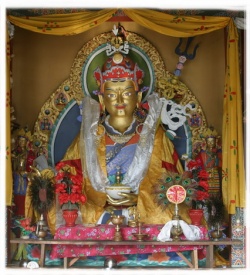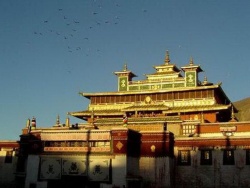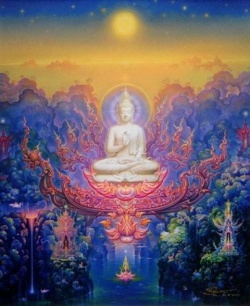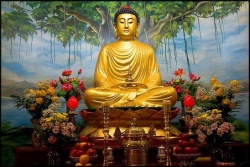Tibetan Chan II: the teachings of Heshang Moheyan
In the previous post in this series, we looked at the story of the great debate convened by the Tibetan emperor Trisong Detsen. The debate was to decide between the Chinese and Indian versions of Buddhism that were being taught in Tibet at the time. The Indian teachers favoured the scholastic Buddhism that was found in India’s great monastic universities at the time, while Chinese teachers taught mainly meditation in the style they called Chan (later to become Zen in Japan).
The problem with Chan was that it seemed to dismiss what the Indian teachers were presenting as the essentials of Buddhism, that is, virtuous acts and analytical philosophy leading to wisdom. The Chan teachers chracterised the duality of virtue and nonvirtue and the practice of analysis itself as just the kind of thing that gets in the way of real wisdom. All one had to do, they claimed, was stop making distinctions, whether between virtue and nonvirtue, existence and nonexistence, or any dualities at all.
According to Tibetan histories, the Indian side won the debate decisively–understandably enough, as the anti-analytical approach of the Chan teachers was not best suited to the arena of intellectual debate. The King decreed that Tibetan Buddhism was to follow the Indian example, and the Chinese teachers were to return to China. Whether things really happened in this way, Tibetan historians certainly saw this as a decisive moment in Tibet’s religious history, and never failed to tell the story of the debate. Thus even the debate’s loser achieved a lasting fame, or notoriety. Heshang Moheyan (or Hwashang Mahayan to Tibetans) came to be an emblem of a particular kind of erroneous meditation: the idea that all you have to do to achieve enlightenment is shut down all mental activity.
Some Tibetans of a more analytical bent used the Heshang as a polemical stick to beat the meditation traditions that stressed nonconceptual awareness, like Dzogchen and Chagchen. But this was hardly fair, since within even these traditions teachers warned meditators of falling into the extreme of Heshang Moheyan’s blank meditation. Moheyan achieved a long-lasting notoriety in popular culture too, as a figure of fun in ritual dance traditions (as discussed in this recent article).
- * *
IOL Tib J 468Until recently little was known about the real teachings of Heshang Moheyan except through the Tibetan histories which, written by the spiritual descendants of the winning side of the debate, were unlikely to offer a completely fair representation. Then with the opening of the Dunhuang cave, we suddenly had quite a number of manuscripts apparently written by followers of Tibetan Chan, recording the sayings of Chan masters like Moheyan himself. Great work on piecing together the Dunhuang fragments of Moheyan’s writings has been done by Luis Gomez, and I will look at just one of these manuscripts here, IOL Tib J 468. I want to ask if we can establish whether Moheyan really taught a kind of ‘blank’ meditation, or something a little less extreme. Let’s see.
In his description of meditation, Moheyan writes this:
When you are engaged in contemplation itself, look at your own mind. Then, the lack of any mental activity at all is non-thought. If there is movement of the conceptual mind, be aware of it. “How should one be aware?” Do not analyse the mind which is moving in terms of any kind of quality at all: do not analyse it as moving or not moving; do not analyse it as existing or not exising; do not analyse it as virtuous or non-virtuous; and do not analyse it as defiled or pure. If you are aware of mind in this way, it is natureless. This is the practice of the dharma path.
Well, there is certainly mention here of “the lack of any mental activity.” But the rest of the passage concerns what to do when there is mental “movement”. Interestingly, Moheyan does not suggest suppressing this movement. What he says is: be aware of it without analysing it. What kind of awareness is he talking about? The Tibetan word is tshor, which is used here as a translation for the Chinese character jue 覺 meaning ‘awakening’, ‘illumination’ or ‘awareness’. These words seem a long way from the blankness that Moheyan is supposed to have experienced in his meditation practice. Indeed it seems that he is telling his students here not to suppress mental movement, but to leave it to move in the context of an awareness that does not distinguish it into dualistic extremes.
- * *
Another aspect of Moheyan’s teachings, which I’ll just touch on here, is the fact that he only recommends this technique of meditation to ‘those of sharp faculties’. Others, he says, do need to use various graduated methods. Just what percentage of people he considered to possess these ‘sharp faculties’ is not made clear, but perhaps not so many. In any case, we can see that Moheyan’s teachings were not so radical as they were painted in the later Tibetan tradition. They even seem, dare one say it, quite reasonable…
- * *
References
1. Demieville, Paul. 1952. Le Concile de Lhasa. Paris: Imprimeries Nationale de France.
2. Gomez, Luis. 1983. “The Direct and Gradual Approaches of Zen Master Mahāyāna: Fragments of the Teachings of Moheyan,” in Studies in Ch’an and Hua-yen, edited by Gimello and Gregory: 393–434.
3. Schrempf, Mona. 2006. “Hwa shang at the Border: Transformations of History and Reconstructions of Identity in Modern A mdo.” JIATS 2: 1-32
Tibetan text
IOL Tib J 468: (1v) //bsam gtan nyId du ‘jug pa’I tshe/ bdag gI sems la bltas na/ cI yang sems dpa’ myed de myI bsam mo/ rtog pa’I sems g.yos na tshor bar bya/ cI ltar tshor bar bya zhe na/ gang g.yos pa’I sems de nyId/ g.yos pa dang ma g.yos par yang myI brtag/ yod pa dang myed par yang (2r) myI brtag/ dge ba dang myI dge bar yang myI brtag/ nyong mongs pa dang rnam par byang bar yang myI brtag/ ste// chos thams cad cI lta bur yang myI brtag go// sems g.yos pa de lta bur tshor na rang bzhin myed pa yIn te/ /de nI chos lam spyod pa zhes bya’//



